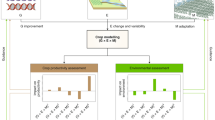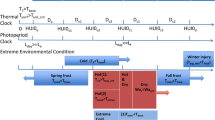Abstract
Climate change has been projected to significantly affect agricultural productivity and hence food availability in the coming decades. The uncertainty associated with projecting climate change impacts is a barrier to agricultural adaptation. Despite uncertainty quantification becoming more prominent in impact studies, the thorough quantification of more than one uncertainty source is not commonly exercised. This work focuses on Indian groundnut and uses the General Large Area Model for annual crops (GLAM) to investigate the response of groundnut under future climate scenarios, develop a genotypic adaptation strategy, and quantify the main uncertainty sources. Results suggest that despite large uncertainty in yield projections (to which crop- and climate-related sources contribute 46 and 54 %, respectively) no-regret strategies are possible for Indian groundnut. Benefits from genotypic adaptation were robust towards the choice of climate model, crop model parameters and bias-correction methods. Groundnut breeding for 2030 climates should be oriented toward increasing maximum photosynthetic rates, total assimilate partitioned to seeds, and, where enough soil moisture is available, also maximum transpiration rates. No benefit from enhanced heat stress tolerance was observed, though this trait may become important as warming intensifies. Managing yield variability remains a challenge for groundnut, suggesting that an integral approach to crop adaptation that includes year-to-year coping strategies as well as improvements in crop management is needed across all India.




Similar content being viewed by others
References
Asseng S, Ewert F, Rosenzweig C, et al. (2013) Uncertainty in simulating wheat yields under climate change. Nat Clim Chang 3:827–832
Balota M, Isleib TG, Tallury S (2012) Variability for drought related traits of Virginia-type peanut cultivars and advanced breeding lines. Crop Sci 52:2702–2713
Banterng P, Patanothai A, Pannangpetch K, et al. (2003) Seasonal variation in the dynamic growth and development traits of peanut lines. J Agric Sci 141:51–62
Batjes NH (2009) Harmonized soil profile data for applications at global and continental scales: updates to the WISE database. Soil Use Manag 25:124–127
Bhatia VS, Singh P, Kesava Rao AVR, et al. (2009) Analysis of water non-limiting and water limiting yields and yield gaps of groundnut in India using CROPGRO-peanut model. J Agron Crop Sci 195:455–463
Bhatnagar-Mathur P, Devi MJ, Reddy DS, et al. (2007) Stress-inducible expression of at DREB1A in transgenic peanut (Arachis hypogaea L.) increases transpiration efficiency under water-limiting conditions. Plant Cell Rep 26:2071–2082
Brown RH, Byrd GT (1996) Transpiration efficiency, specific leaf weight, and mineral concentration in peanut and pearl millet. Crop Sci 36:475–480
Challinor AJ, Wheeler TR (2008) Use of a crop model ensemble to quantify CO2 stimulation of water-stressed and well-watered crops. Agric For Meteorol 148:1062–1077
Challinor AJ, Wheeler TR, Craufurd PQ, et al. (2004) Design and optimisation of a large-area process-based model for annual crops. Agric For Meteorol 124:99–120
Challinor AJ, Wheeler TR, Craufurd PQ, Slingo JM (2005) Simulation of the impact of high temperature stress on annual crop yields. Agric For Meteorol 135:180–189
Challinor AJ, Wheeler TR, Craufurd PQ, et al. (2007) Adaptation of crops to climate change through genotypic responses to mean and extreme temperatures. Agric Ecosyst Environ 119:190–204
Challinor A, Wheeler T, Hemming D, Upadhyaya H (2009) Ensemble yield simulations: crop and climate uncertainties, sensitivity to temperature and genotypic adaptation to climate change. Clim Res 38:117–127
Challinor AJ, Watson J, Lobell DB, et al. (2014) A meta-analysis of crop yield under climate change and adaptation. Nat Clim Chang 4:287–291
Donald CM, Hamblin J (1976) The biological yield and harvest index of cereals as agronomic and plant breeding criteria. Adv Agron pp:361–405
FAO (2014) FAOSTAT Statistical Database. Food and Agriculture Organization of the United Nations, Rome, Italy
Gourdji SM, Sibley AM, Lobell DB (2013) Global crop exposure to critical high temperatures in the reproductive period: historical trends and future projections. Environ Res Lett 8:24041
Hammer GL, Sinclair TR, Boote KJ, et al. (1995) A peanut simulation model: I. Model development and testing. Agron J 87:1085–1093
Hawkins E, Osborne TM, Ho CK, Challinor AJ (2013) Calibration and bias correction of climate projections for crop modelling: an idealised case study over Europe. Agric For Meteorol 170:19–31
Jyostna Devi M, Sinclair TR, Vadez V, Krishnamurthy L (2009) Peanut genotypic variation in transpiration efficiency and decreased transpiration during progressive soil drying. F Crop Res 114:280–285
Jyostna Devi M, Sinclair TR, Vadez V (2010) Genotypic variation in peanut for transpiration response to vapor pressure deficit. Crop Sci 50:191–196
Knutti R, Sedláček J (2012) Robustness and uncertainties in the new CMIP5 climate model projections. Nat Clim Chang 3:369–373
Koehler A-K, Challinor AJ, Hawkins E, Asseng S (2013) Influences of increasing temperature on Indian wheat: quantifying limits to predictability. Environ Res Lett 8:34016
Mehrotra N (2011) Groundnut. Department of Economic Analysis and Research. National Bank for Agriculture and Rural Development, Mumbai, India
Nageswara Rao RC, Nigam SN (2003) Genetic options for drought management in groundnut. In: Saxena NP (ed) Management of agricultural drought: agronomic and genetic options. Oxford & IBH Publishing Co. Pvt. Ltd., New Delhi, India, pp 123–141
Nigam SN (2009) Crop improvement strategies in groundnut. J Agric Sci:1–12
Nigam S, Aruna R (2008) Stability of soil plant analytical development (SPAD) chlorophyll meter reading (SCMR) and specific leaf area (SLA) and their association across varying soil moisture stress conditions in groundnut (Arachis hypogaea L.). Euphytica 160:111–117
Nigam SN, Upadhyaya HD, Chandra S, et al. (2001) Gene effects for specific leaf area and harvest index in three crosses of groundnut (Arachis hypogaea). Ann Appl Biol 139:301–306
Phakamas N, Patanothai A, Pannangpetch K, et al. (2008) Seasonal responses and genotype-by-season interactions for the growth dynamic and development traits of peanut. J Agric Sci 146:311–323
Rajeevan M, Bhate J, Kale JD, Lal B (2006) High resolution daily gridded rainfall data for the India region: analysis of break and active monsoon spells. Curr Sci 91:296–306
Ramirez-Villegas J, Challinor AJ, Thornton PK, Jarvis A (2013) Implications of regional improvement in global climate models for agricultural impact research. Environ Res Lett 8:24018
Ramirez-Villegas J, Koehler A-K, Challinor AJ (2015) Assessing uncertainty and complexity in regional-scale crop model simulations. Eur J Agron. doi:10.1016/j.eja.2015.11.021
Rötter RP (2014) Agricultural impacts: robust uncertainty. Nat Clim Chang 4:251–252
Sacks WJ, Deryng D, Foley JA, Ramankutty N (2010) Crop planting dates: an analysis of global patterns. Glob Ecol Biogeogr 19:607–620
Sheshshayee MS, Bindumadhava H, Rachaputi NR, et al. (2006) Leaf chlorophyll concentration relates to transpiration efficiency in peanut. Ann Appl Biol 148:7–15
Singh P, Boote KJ, Kumar U, et al. (2012) Evaluation of genetic traits for improving productivity and adaptation of groundnut to climate change in India. J Agron Crop Sci 198:399–413
Singh P, Nedumaran S, Ntare BR, et al. (2013) Potential benefits of drought and heat tolerance in groundnut for adaptation to climate change in India and West Africa. Mitig Adapt Strateg Glob Chang 19:509–529
Tao F, Zhang Z, Liu J, Yokozawa M (2009) Modelling the impacts of weather and climate variability on crop productivity over a large area: a new super-ensemble-based probabilistic projection. Agric For Meteorol 149:1266–1278
Taylor KE, Stouffer RJ, Meehl GA (2012) An overview of CMIP5 and the experiment design. Bull Am Meteorol Soc:1–39. doi:10.1175/BAMS-D-11-00094.1
Themeßl JM, Gobiet A, Leuprecht A (2011) Empirical-statistical downscaling and error correction of daily precipitation from regional climate models. Int J Climatol 31:1530–1544
Uppala SM, KÅllberg PW, Simmons AJ, et al. (2005) The ERA-40 re-analysis. Q J R Meteorol Soc 131:2961–3012
Vara Prasad PV, Boote KJ, Hartwell Allen L, Thomas JMG (2003) Super-optimal temperatures are detrimental to peanut (Arachis hypogaea L.) reproductive processes and yield at both ambient and elevated carbon dioxide. Glob Chang Biol 9:1775–1787
Ver Hoef JM (2012) Who invented the Delta method? Am Stat 66:124–127
Vermeulen SJ, Challinor AJ, Thornton PK, et al. (2013) Addressing uncertainty in adaptation planning for agriculture. Proc Natl Acad Sci U S A 110:8357–8362
Acknowledgments
This study was funded by the CGIAR Research Program on Climate Change, Agriculture and Food Security (CCAFS). We acknowledge the World Climate Research Programme’s Working Group on Coupled Modelling, which is responsible for CMIP, and we thank the climate modelling groups for producing and making available their model output. We thank two anonymous reviewers for their insightful feedback on an earlier version of this manuscript. We thank Dr. Andy Jarvis from CIAT for title suggestion.
Author information
Authors and Affiliations
Corresponding author
Electronic supplementary material
ESM 1
(PDF 3859 kb)
Rights and permissions
About this article
Cite this article
Ramirez-Villegas, J., Challinor, A.J. Towards a genotypic adaptation strategy for Indian groundnut cultivation using an ensemble of crop simulations. Climatic Change 138, 223–238 (2016). https://doi.org/10.1007/s10584-016-1717-y
Received:
Accepted:
Published:
Issue Date:
DOI: https://doi.org/10.1007/s10584-016-1717-y




